When applying or repairing wiring, you have to mount wires and cables. Also, if necessary, the installation of new powerful household appliances has to sometimes pull a separate line from the electrical tailor. In any case, it is necessary to somehow mount the wires on the wall or ceiling. What could be the cable mount for each of these cases and will continue to understand.
General rules
With hidden or open mounted cable, indoors or on the street there are several general rules:
- The optimal distance between the fastener is 40-50 cm.
- If the screws, screws, dowels are used, they are twisted until it stops - so that the sticking hat does not damage the isolation.
- The cable is laid uniformly, without humps. If a stock is needed, it is placed in the least noticeable place.
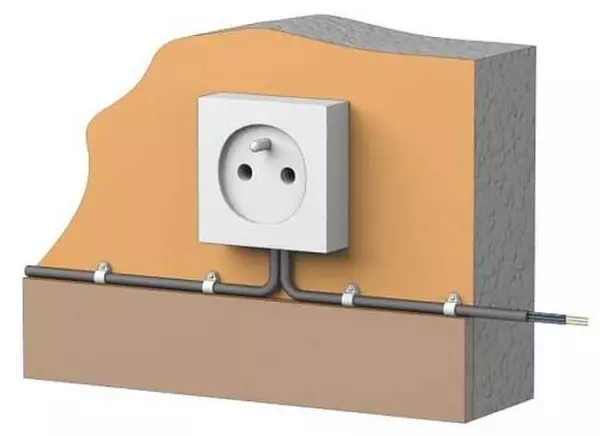
Stop the cable is preferably in a straight line - vertically or horizontally
In principle, the recommendations are all. They are universal and easy. The distance can be reduced if necessary. For example, on the rotations of the track, the fasteners are installed at a short distance from the bend place - 5-10 cm. The task is to ensure reliable fixation and prevent sagging.
Methods for fastening to different surfaces
Walls and ceilings make from various materials with different structure and density. Depending on this characteristic, the method of fastening changes:
- Dense - wood in any form, plaster and soft plaster solutions (including gypsum). In all these materials, a nail or self-tapping comes perfectly. In some - chipboard, OSP and some others - it is better to better drill a hole slightly smaller diameter than self-tapping screw, and then screw it up. Nails are more often clogged immediately without prior drilling.
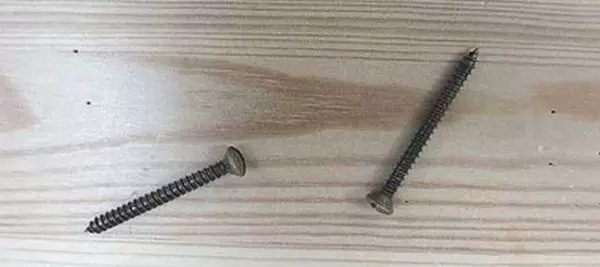
Self-tapping screws are screwed in wood and products. Only for fastening the cable is better to take them with a flat hat.
- Solid. This category of materials includes bricks, concrete, screeds, cements. In them, even with a previously drilled hole, do not screw the screws. For such materials, dowel-nails are used (they are also called dowels). This is a fastener consisting of two parts - a plastic cap-dowel and metallic (sometimes plastic) screw. In such cases, a hole is drilled in the material with a diameter of the drill to equal or slightly smaller than the diameter of the dowel. Plastic cap is inserted into the hole. Its upper edge should be on the same level with the surface (if necessary, you can knock on the hammer a couple of times to compare or cut off the surplus with a sharp knife). Then the fastening element is superimposed (plate, clamp, etc.), which is attached to the inserted dowel with a screw.
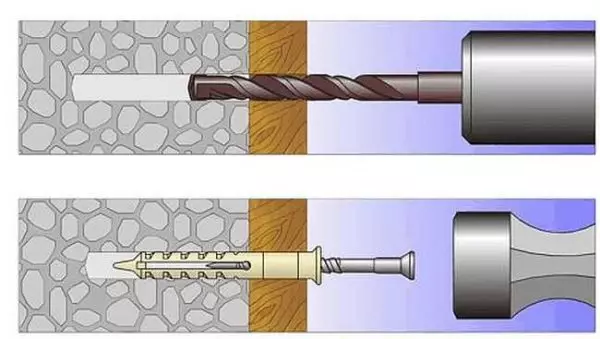
Dowel installation
- Thin or soft. This is plastic, plasterboard, fiberboard, aerated concrete, foam concrete, etc. In them, the usual fastener does not hold, you need a special, which has an extended "back" part. It has a large area of support, due to which it can hold fasteners. Some examples of such a fastener (umbrella, a butterfly dowel and a dowel with a drill) are presented in the photo.
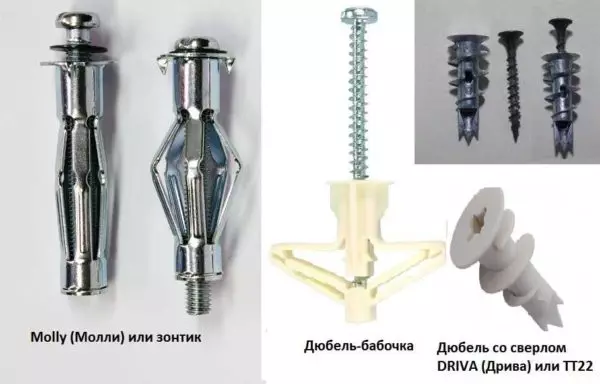
For fastening cable to thin walls need special fasteners
Actually, these are all surfaces that are found inside the house when laying wiring. But the cable sometimes needs to be attached to the post, for example, when the input of electricity from the post to the house stretches or to the pipe - when the cable rises in a combustible wall.
To concrete pole
To reinforced concrete pole, the cable is fastened with long plastic black screeds. They serve about 5 years.
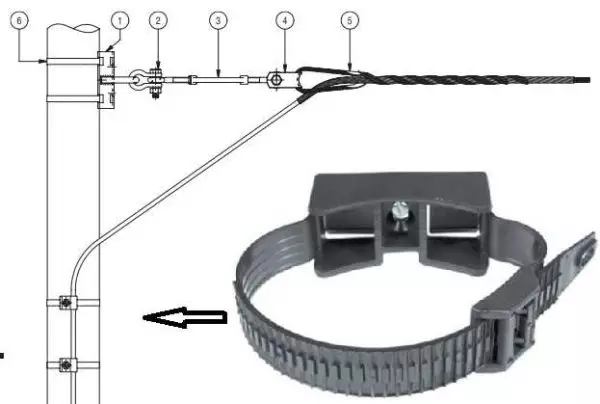
One way to lower the cable along the reinforced concrete post
You can use clamps for mounting sewage pipes, but under them it is necessary to drill holes, which is very difficult. Another option is if there is a ground wire on the pole - a round wire with a diameter of 5-6 mm, then you can fix the screeds to it. Another option is to secure the metal stripes on the post - to do something like clamps, and the cable is fixed to them.
In metal pipe
If the cable rises along the wall of the house in the metal pipe, it is simply triggered inside. Since rather solid cables are used for outer wiring, it is usually enough of it to become more or less kept inside the pipe.
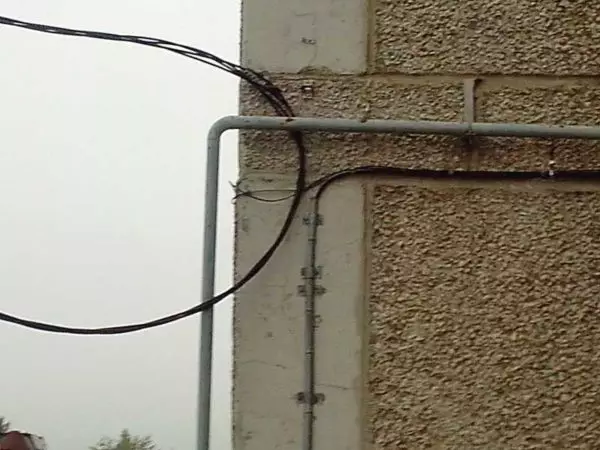
Laying cable in a pipe. Fasten the pipe, and cable only to get out of it to the wall
From above and below the pipe is closed with some cork (you can cut out of the foam and then paint together with the pipe). This cork will additionally fix the position of the cable (not pressing to the edge), and so that it does not move inside the pipe, it is fixed to the wall to get out of it.
To cable
Special metal and plastic suspensions are used to fasten the cable to the cable. They consist of two parts - there is a cable hole and more - for laying cables.

Suspensions for fixing the cable to the cable
What are better - metal or plastic? Metal are more durable, but it is set longer - it is necessary to twist the screw. Plastic serve will be about 5 years, but are installed quickly - the "tail" is pulled into the appropriate hole, is delayed. That's all.
Fasteners for cable and wires: species and varieties
With the forehead type of electrical wiring and cable, the same types of fasteners can be used. It is selected on the basis of the existing conditions, the possibilities and tastes of the owners. The main task is to provide high-quality fixation and not disturbing isolation at the time of installation, nor during further work and operation. And pick the type of fastening from possible options. There are quite a lot of them - there are special, which are produced specifically for cables, there are borrowed from other areas, there are homemade.
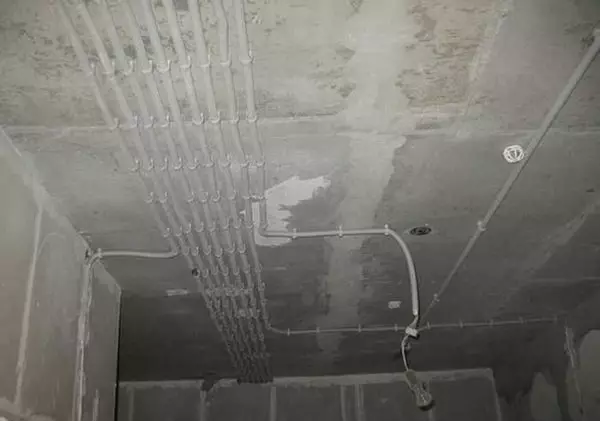
Cable mount options
Clips for fixing the cable
With the help of the clips, you can fix the cable on the wall, the ceiling, on the floor. You just have to choose the correct design, and there are a lot of them. Cable mount Clips is a very popular method - it can work very carefully and almost imperceptibly. This is if an open wiring laying is assumed.
Clips for mounting cable are metal and plastic, with different shapes. The simplest people have a form of a handicuit, from one and on the other hand there are holes for a self-tapping screw or dowel. They all are good, but two holes must be drilled for installation, and it takes a lot of time.
There is an option that allows you to withstand the fire gap when installing the power cable on the combustible surfaces (in the photo on the left). This fastener is fixed with one self-tapping screw to the surface. It is good because, if necessary, you can add threads to the same fastener. To do this, you will not have to shoot it, you will need to unscrew the screws holding the upper part of the clips.

Metal clips for fixing the cable
The third option is a peculiar loop of a metal strip. To install it first, you need to start the cables inside, then combine the holes and fix on the surface.
All these clips can be used both on the wall and on the ceiling. But when laying a large amount of threads on the ceiling, they are uncomfortable - too much required holes for mounting. They are made of metal, the part is then stained - so that with the outer gasket the fastener has been released less.
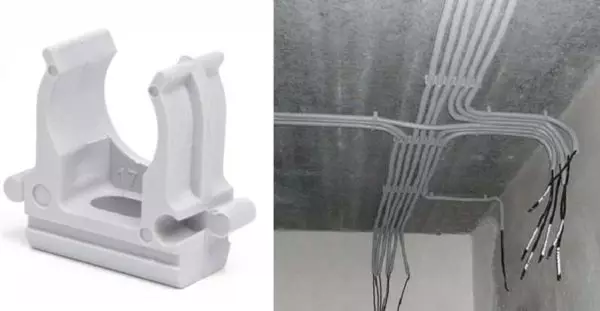
Installation on plastic clips
Plastic clips are used mainly for fixing cables in corrugated hoses. They are different sizes for various diameters of corrugations. It can be installed both one to assemble in the ruler - for more accurate installation of large wiring bundles. This type of clips is used mainly for hidden gasket, but if the corrugation is laid outside, it is more convenient to fix it with their help.
Dowel Clips
A more imperceptible when installing is a dowel clip. This is a curved band of plastic with characteristic branches at the ends, which by the force of elasticity will keep fasteners in the wall or ceiling. The form of these products is for round and flat cables of different sizes. But they will not secure serious cables - are not enough. But very carefully look at the conductors of small sections, including television, telephone and for the Internet.
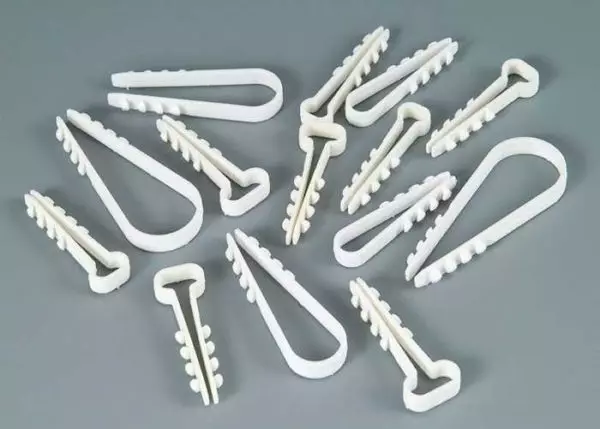
Dowel clips for cables of different shapes
They are installed simply: the hole of the suitable diameter is drilled, the conductor will start in the clip, the ends are refilled into the hole and the effort is inserted there. A really good option - quickly mounted, you look neat. Used mainly for open wiring.
Dowel-tie
Another option for quickly fastening the cable is a dowel screed. It is performed from non-combustible self-tapping plasticates, allows you to quickly mount cable lines. It can be used for both open and hidden mounting.
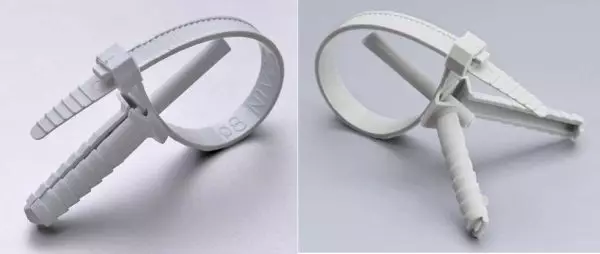
Dowel-screed - a quick and convenient way to fasten the cable to concrete, brick and other surfaces
There is a screed with a detachable and in-point lock. The plug-in lock allows you to change the number of wires if necessary. The method of installation is the same as an ordinary dowel. The difference is that the dowel here is also plastic.
Cable ties with platform under the dowel (SSP)
Another option for quick installation. It consists of a dowel with a thread and a platform with a screed attached to it. First, the dowel is installed, the platform with a screed is screwed. The wires are attached to the finished track.
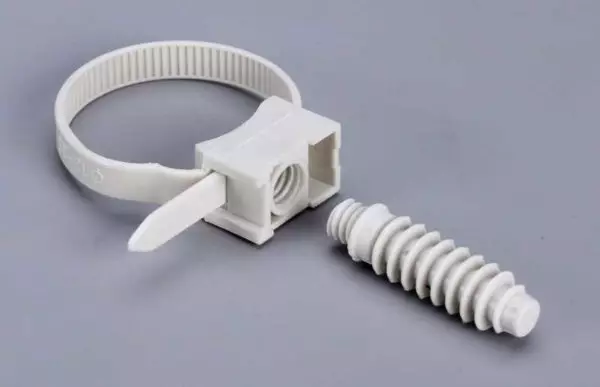
SSP - cable screed with mounting platform under a dowel
Material - non-combustible plasticity, color - gray, use temperature - from -45 ° C to + 85 ° C. Can be mounted on concrete, brick and wooden surfaces.
Clips (brackets) with nail
An excellent option for fastening the cable to dense surfaces - wood and its derivative, plaster. On the side of the plastic bracket there is a hole in which the carnations is inserted. The form of a bracket is round rectangular - under different form of conductors.
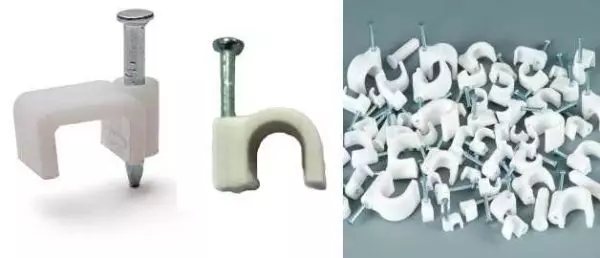
Plastic brackets with nails for open cable mounting
The cable fastening with such brackets is fast and not striking. Most often, also fasten small wire sizes - television, telephone, for the Internet.
U-shaped stapler brackets
Even the smallest brackets and clips are still quite noticeable. There is a way to make fasteners practically invisible, in any case in some cases. If there is a construction stapler to wooden surfaces or plaster, the wires and telephone cables can be attached to special brackets. They have long legs and a rounded back. There are special brackets for a stapler, intended for mounting a cable with plastic limiters (average drawing). They do not allow the wire to transmit the wire, which happens when working with conventional brackets, if there is too much effort on the trigger mechanism.

Mounting cables with a stapler and special brackets
It is good way to high speed - just one press on the staple lever and the bracket is already installed. For an hour, you can fix a decent metrah. Another positive moment - fasteners are minority, with a dismantling in the wood there are very small holes, which are also practically invisible. With plaster and chipboard, OSP is somewhat more complicated - damage can be more, however, they are still less noticeable than from nails, even the smallest.
The lack of fastening the cable stapler is significant limitations in size. Such staples are not large. The maximum size in the width of the bracket is 12.5 mm, and it is not in all kinds. This is more than enough for the installation of telephone "noodles", the Internet cable or other similar conductors, but already a VVG or NYM in this way to fasten is far from always. In addition, these cables are isolation is tougher, which requires more frequent installation of the bracket.
Fasteners for ordering the beam of conductors
Not always wires must be fixed inpatient. In some cases, it is just necessary to streamline bundles - so that they are not confused. For example, a considerable amount of wires usually comes to the desktop. To fixes them hard to anything - after a while they may need to be alterated, and the holes remain from the driven nails, which on the table do not disguise anything on the table. Here for these purposes there are various devices. They are more often called wire holders or cable.
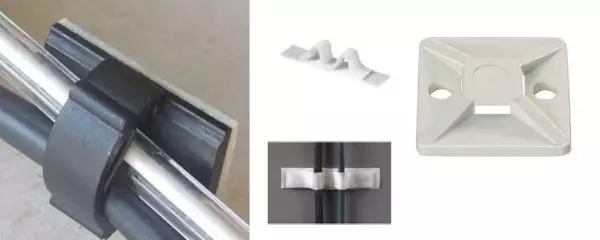
Velcro Cable Clips
For example, the same brackets, but another building. On the right in the photo above you see a cable clips, which is attached to the back of which is attached double-sided sticky tape. For fastening on furniture or plastic panels, it is very convenient - the glue can then be washed, and the surface remains intact. In the center - the second option with the same idea, and on the left the so-called mounting area for fastening cable ties. At first, these sites are attached to the surface - they also have velcro on the back. Then the beam of the wires is attached to the holes with a conventional plastic screed. Not so convenient and neatly (tails of the screeds will hang around), but can also be used.
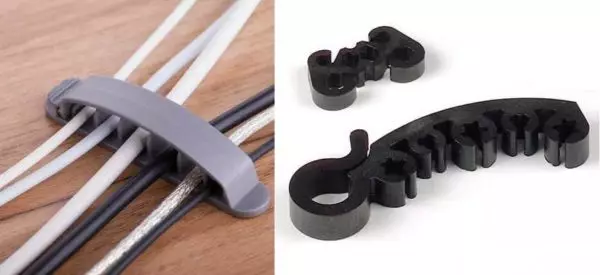
Plastic cable holders on the table
A few more options for fastening the harness of electrical wires you see in the photo above. The essence is one, the technique is different.
Cable trays - for hidden laying of large beams
When the ceiling backlight device, a large amount of wires have to be ladered, and they are fixed to the ceiling overlap. If we are talking about apartments, then the overlaps most often - a concrete slab. To drill holes in it hard and long, fixing alone or small wire groups is not much easier. For such cases, suspended cable trays are used. Make them usually from galvanized wire or perforated metal.
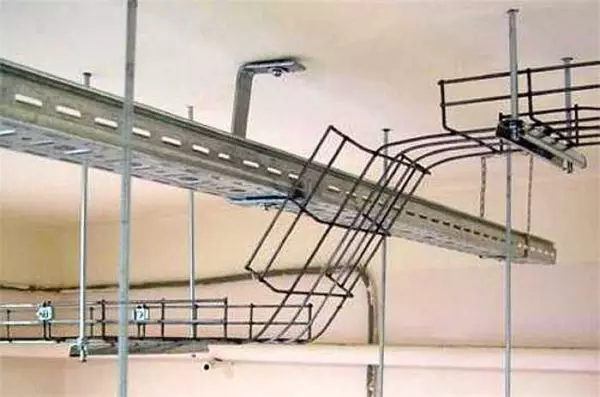
Suspended trays for cables
They have different sizes, there are several different types of fastening - on studs attached to the ceiling, on the suspensions "T" or "g"-shaped form.
The order of installation is: first the design is going and mounted on the ceiling, then cables are thrown into it. If you wish, they can be consolidated with screeds to lattices, but usually there is no need.
In addition, there are metal trays from perforated and non-perforated metal. The latter are needed when laying cables inside the combustible walls - in frame houses, for example.
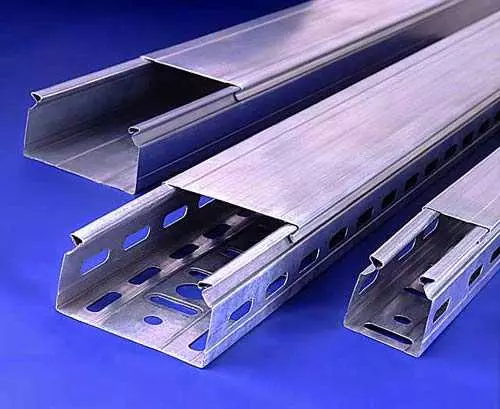
Metal cable trays
The same trays can be used when laying cables in the underground space. But then you can apply a perforated option. It also wonderfully protects from rodents and accidental damage.
Homemade cable fixtures
Many factory devices have a relatively low price, but when hundreds are required, the amount falls a lot of money. And if the wiring is hidden - it is required, for example, fasten the cable in the stroke, why inspire extra money, if you can do with underloading means. This is what self-made cable fastening is made:
- Strips of tin + nails or dowels - depending on the material of the wall. Tin is preferably galvanized, and it can be "mined" from beer cans. Cut into strips with a thickness of 7-10 mm, in the center make a hole in which a nail has been done. First, along the route with a step of 60-100 cm, fasteners are fastened, then cable or wire clamp with tin strips. To secure the cable to be reliable, the ends are preferably clamping into the castle.
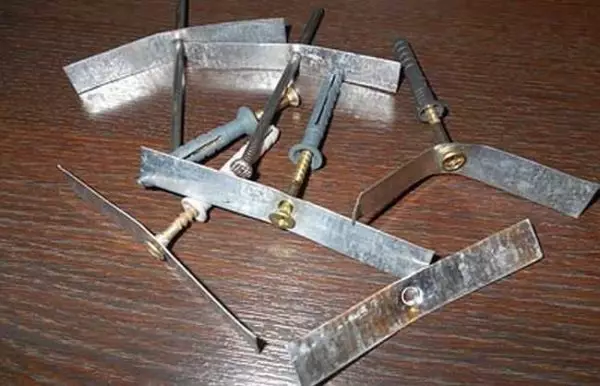
Example of self-made fasteners for cable
- From a galvanized metal, cut into strips with a thickness of about 1 cm. You can make the simplest U-shaped bracket. At the ends, nails, use as conventional brackets - grabbing the conductor every 50-80 cm. You can use for fastening wires to walls and ceiling.
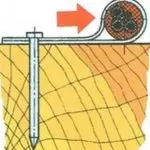
How can I fix the wire with a strip of tin
- Also, the strip of the tin can be used to mount the cable in the loop. The strip covers the cable after which the strip is attached to the wall (see photo on the right). This option can also be used to fix the conductors in the stroke. From the usual outdoor attachment it will only be distinguished by the step of installing the clamps - they can be rated less often, as the task of them is to hold the cables until the solution is forged that the shroud is close. In the same way, the wires in the protective sheath - corrugation, pipe, etc. can be fixed. Only bands will be required greater length and, possibly widths - for more reliable fixation. For wood, a nail or self-tapping screw is suitable for bricks and concrete a dowel.
- Punching facilities can be fixed and beams of wires. A longer strip of tin can be mounted somewhat located one near other conductors. It is more convenient for this to use perforated metal (for example, mounting suspensions for suspended ceilings), but you can do the usual stripes of tin.
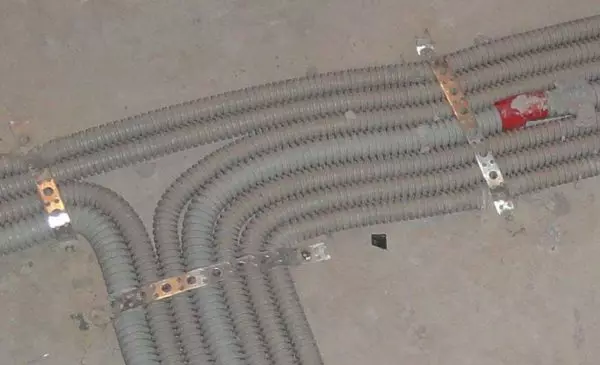
Fixation of beams of wires
These are the main types of fasteners for a cable that can be made with your own hands. Surely there are other options - fantasy cleaners are inexhaustible, but these are the most common.
Fasteners for hidden gasket
If cables fit at the repair stage, they are increasingly resorted to styling inside walls, floor or ceiling. Since the result of the work is not least, the aesthetics is paid to the minimum of attention. But much attention is paid to reliability and security - access for rework is very and very complicated. Therefore, fasteners for cable when laying inside the wall, ceiling, under the floor is chosen reliable. It can be:
- Schedules of any type - with dowels, mounting sites, etc.
- You can choose a suitable size of the clip.
- Make homemade fasteners.
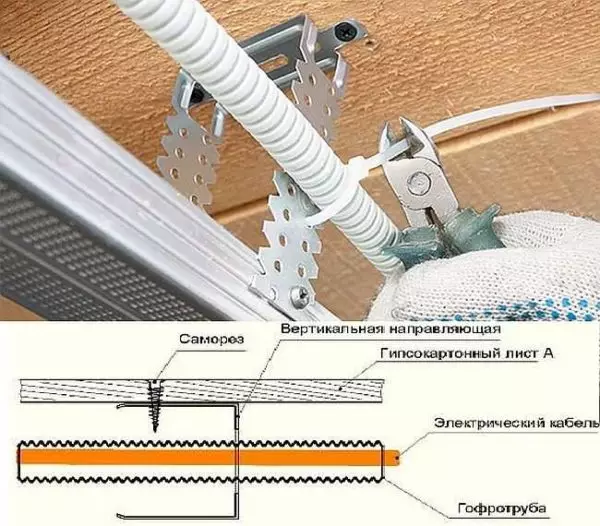
If you make a suspended ceiling of drywall, the wiring can be mounted for suspensions or lay inside profiles. Only when installing the cables do not lay close to the profile wall - to not damage when working
For laying large beams of wires on the ceiling it is more convenient and faster to use trays, but you can all the same fastener. The only thing is bad - you have to drill a lot of holes for the installation of fasteners in concrete or brick. It is especially inconvenient when working on the ceiling. How best to optimize work in this case is slightly lower.
If there is no suggestion of false walls or finishing gender, the wires are deepened - shoes. They put the wires, then they are smeared with a solution and after already producing finishing finish. Stacks of view of aesthetics version perfect. From the point of view of operation, it is problematic, as it is almost impossible to replace or repair the wiring. Nevertheless, the wiring is done in this way, just trying to lay high-quality cables, and even with some power margin or the number of pairs.
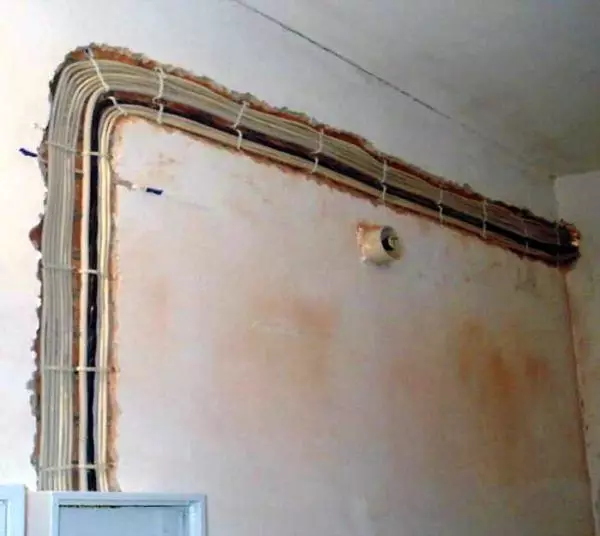
Gasket and fastening wires in the stroke
According to the safety rules in combustible walls (wooden, panel and frame), the cable in the non-combustible shell or in the all-metal tray is laid. If we are talking about a non-combustible shell, then it is usually a corrugation from unsupporting plastic burning. In this case, the shell actually fastens, inside which the cable is located. It does not particularly affect the choice of fastening type, but affects the selection of fasteners - it is simply necessary that the locks can cover the shell.
The laying of cables inside the combustible walls is associated with difficulties: the requirements are very tough. They can be performed in frame or panel houses, but it is very difficult in the bars or in the cuts. It is necessary to put all-metal trays into the walls. At the same time, it is necessary to take out a large amount of wood that does not improve the heat engineering characteristics and the appearance is not ideal, it is not possible. Therefore, in wooden houses, they are more often resorted to the open method of installation - over the walls.
Fasteners for open cable laying
With an outdoor cable laying, more stringent requirements are imposed about the appearance of the fastener. Since everyone in sight needs to select the most imperceptible options or on the contrary, the most decorative, such as retro-wiring. This is an extensive topic and described in detail here. Other options:
- Installation in cable channels. These are plastic trays that are attached along the walls. The method is not the best in terms of aesthetics, but if necessary, laying a large number of wires in wooden houses is perhaps the cheapest when installing and convenient from the point of view of operation: Always free access for replacement, repair and upgrades.
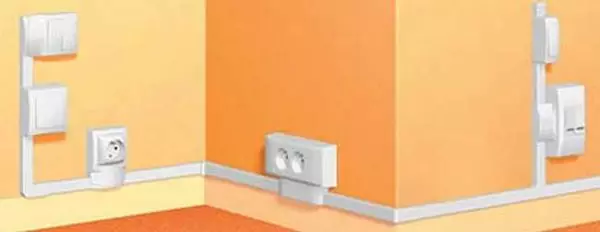
You can put the wires to the cable channels
- Laying a certain amount of wires in special plinths.
- Use the stapler brackets. The most imperceptible fastener, besides installed quickly.
- Fastening with brackets and clips painted in tone with cable.
There is a choice, but all the ways are imperfect, because everyone decides for themselves as it is and how the cable is fixed.
Fastening cables to the ceiling
Fastening the cables to the ceiling occurs mainly when the tension ceilings or ceilings are made of plastic panels and drywall. In the case of plasterboard, everything is somewhat simpler: there is a suspension system to which you can fix the wiring harnesses with plastic screeds. In other cases, everything is somewhat more complicated: you have to drill a large number of holes for fasteners, because all the same clips and brackets use, and under each you need to install a dowel (if the ceiling of the concrete slab).
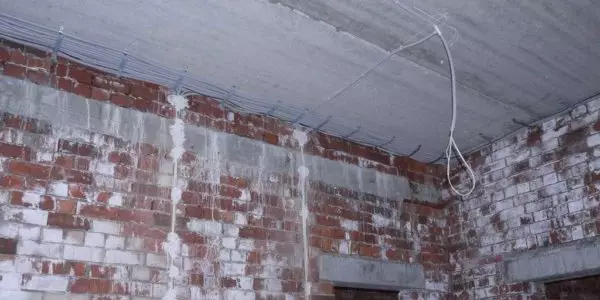
Mounting cable on the ceiling requires a long time
You can speed up the installation in several ways:
- Using cable trays (described above).
- At attaching some lines to the ceiling, hanging small wiring harnesses with plastic screeds.
- Use for fastening a long perforated metal strip.
Article on the topic: How to stick wallpaper on chipboard: work order
